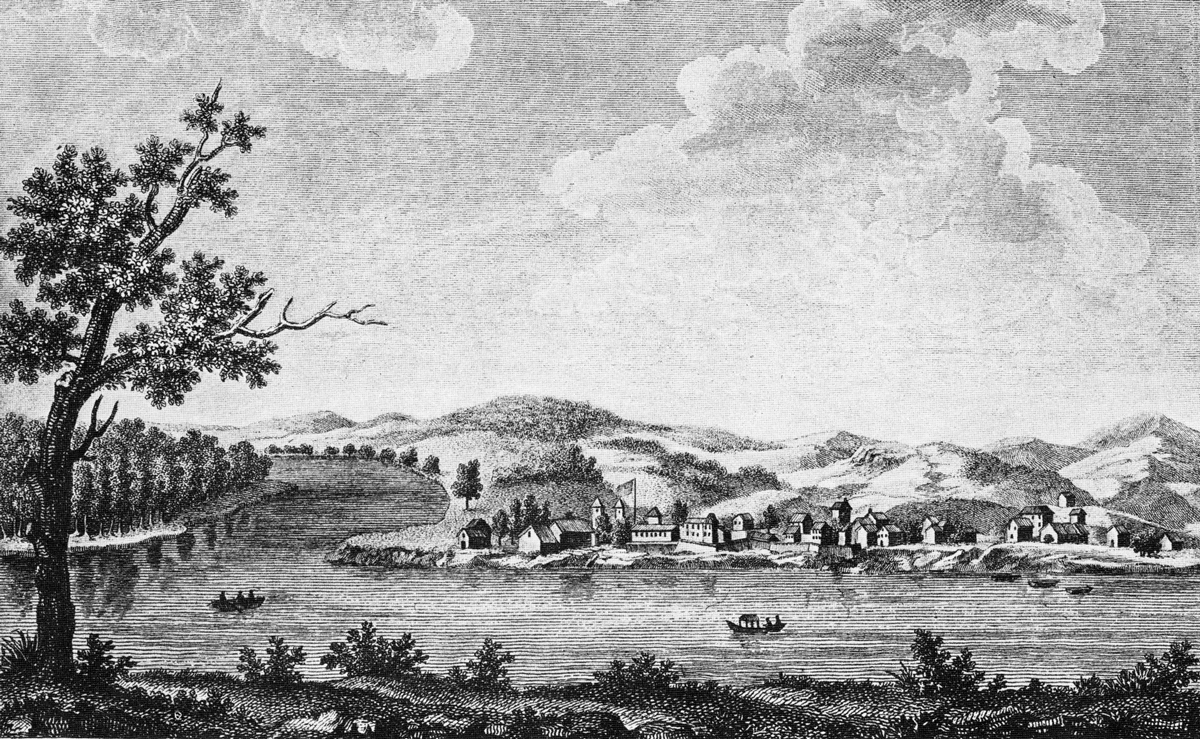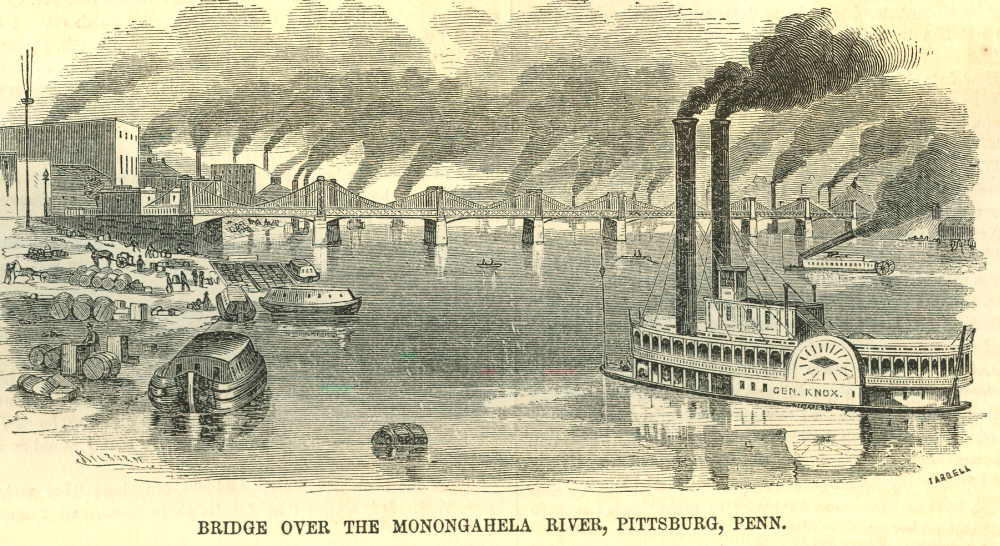Pittsburgh, PA Lewis waits for departure down the Ohio River. Here, the air quality of Pittsburgh is described by late 18th and 19th century visitors.
View of Pittsbourgh (1796)
by Georges Henri Victor Collot (1750–1805) and Joseph Warin (unknown to 1796)
Courtesy Bibliothèque nationale de France.[1]Originally from Victor Collot, A Journey in North America, Containing a Survey of the Countries Watered by the Mississippi, Ohio, Missouri, and Other Affluing Rivers : With Exact Observations on the … Continue reading
“Delightful” Country
The general aspect of the country is delightful; two chains of festooned mountains line the opposite banks of the river of the Alleganies, and that of the Monongahela, stretching towards those of the Ohio. If at their junction the Allegany river did not form an acute angle, which, by its projection, intercepts the magnificent prospective of the Ohio, the situation of Pittsburgh at this spot would perhaps be one of the most pictoresque on the continent.
—Victor Collot[2]Collot, 58.
“Salubrious” Air
The air is very salubrious at Pittsburgh and its environs; intermittent fevers are unknown there, although so common in the southern states, neither are they tormented in the summer with musquitoes. A person may subsist there for one-third of what he pays at Philadelphia. Two printing-offices have been long established there, and, for the amusement of the curious, each publish a newspaper weekly.
—François André Michaux[3]François André Michaux, Travels to the West of the Alleghany Mountains (1805 reprint from London edition), p. 59 in Reuben G. Thwaites, Travels West of the Alleghanies (Cleveland: The Arthur H. … Continue reading
Bridge over the Monongahela River, Pittsburg, Penn.
By Mr. Kilburn and “Tarbell” (possibly Edmund N. Tarbell). “Departure of the Steamer General Knox,” New York Times, 28 August 1854, p. 1.
“Gruesome Offal”
Nearly a century after Lewis was in Pittsburgh waiting for his barge to be built, noted western historian Reuben Gold Thwaites painted the Monongahela scene from Brownsville to Pittsburgh with much a pallet much different from the travelers circa 1800:
The Monongahela is a characteristic mountain trough. . . . The stream, though still majestic in its sweep, is henceforth a commercial slack-water, lined with noisy, grimy, matter-of-fact manufacturing towns, for the most part literally abutting one upon the other all of the way down to Pittsburg, and fast defiling the once picturesque banks with the gruesome offal of coal mines and iron plants. Surprising is the density of settlement along the river. Often, four or five full-fledged cities are at once in view from our boat, the air is thick with sooty smoke belched from hundreds of stacks, the ear is almost deafened with the whirr and roar and bang of milling industries.
—Reuben Gold Thwaites[4]Reuben Gold Thwaites, On the Storied Ohio: An Historical Pilgrimage of a Thousand Miles in a Skiff, from Redstone to Cairo (Chicago: A. C. McClug & Co., 1903), 6–7.
“hell with the lid taken off”
Often misquoted and mis-attributed to Charles Dickens, James Parton’s 1868 Atlantic Monthly article was written to promote Pittsburgh as a travel destination. The following excerpt—three pages before his infamous “hell with the lid taken off” quotation—is sometimes included:
Was there ever such a dismal lookout anywhere else in this world? Those hills, once so beautifully rounded and in such harmony with the scene, have been cut down, sliced off, pierced, slanted, zig-zagged, built upon, built under, until almost every trace of their former outline has been obliterated, without receiving from man’s hand any atoning beauty. The town lies low, as at the bottom of an excavation, just visible through the mingled smoke and mist, and every object in it is black. Smoke, smoke, smoke,—everywhere smoke! Smoke, with the noise of the steam-hammer, and the spouting flame of tall chimneys,—[5]James Parton, “Pittsburgh,” The Atlantic Monthly, January 1868, p. 18 accessed at https://www.theatlantic.com/magazine/archive/1868/01/pittsburg/536130/ on 9 December 2022.
Three pages later, Parton describes one of Pittsburgh’s must see views:
There is one evening scene in Pittsburg which no visitor should miss. Owing to the abruptness of the hill behind the town, there is a street along the edge of a bluff, from which you can look directly down upon all that part of the city which lies low, near the level of the rivers. On the evening of this dark day, we were conducted to the edge of the abyss, and looked over the iron railing upon the most striking spectacle we ever beheld. The entire space lying between the hills was filled with blackest smoke, from out of which the hidden chimneys sent forth tongues of flame, while from the depths of the abyss came up the noise of hundreds of steam-hammers. There would be moments when no flames were visible; but soon the wind would force the smoky curtains aside, and the whole black expanse would be dimly lighted with dull wreaths of fire. It is an unprofitable business, view-hunting; but if any one would enjoy a spectacle as striking as Niagara, he may do so by simply walking up a long hill to Cliff Street in Pittsburg, and looking over into—hell with the lid taken off.”[6]Ibid., 21.
Pittsburgh from the Duquesne Incline, 2019
by Wiki Commons user SkiEngineer. Published under the Creative Commons Attribution-Share Alike 4.0 International license.
“Curious” and “Wonderful”
In the James Parton article quoted above, the author was speaking in what he thought were positive terms. The article’s first paragraph sets the context:
Here are three cities readily accessible to the tourist, which are peculiar,—Quebec, New Orleans, and Pittsburg,—and of these Pittsburg is the most interesting by far. In other towns the traveller can make up his list of lions, do them in a few hours, and go away satisfied; but here all is curious or wonderful—site, environs, history, geology, business, aspect, atmosphere, customs, everything. Pittsburg is a place to read up for, to unpack your trunk and settle down at, to make excursions from, and to study as you would study a group of sciences. To know Pittsburg thoroughly is a liberal education in “the kind of culture demanded by modern-times.”[7]Ibid., 17.
That Parton chose rampant pollution to sell Pittsburgh to potential tourists, speaks to changing societal norms. To this day, “Hell with the lid taken off” is often paired with photographs of Pittsburgh’s “smoky” air, especially following World War II—a period when military necessity trumped environmental justice. As shown in the above photo, Pittsburgh once again approaches F. A. Michaux’s “salubrious” air and Collot’s “delightful” country. Today’s tourist will still find the city “curious or wonderful.”
Notes
| ↑1 | Originally from Victor Collot, A Journey in North America, Containing a Survey of the Countries Watered by the Mississippi, Ohio, Missouri, and Other Affluing Rivers : With Exact Observations on the Course And Soundings of these Rivers, and on the Towns, Villages, Hamlets and Farms of that Part of the New-World, Followed by Philosophical, Political, Military and Commercial Remarks and by a Projected Line of Frontiers and General Limits, Illustrated by 36 Maps, Plans, View and Divers Cuts (Paris: Arthus Bertrand, 1826), Plate 5. |
|---|---|
| ↑2 | Collot, 58. |
| ↑3 | François André Michaux, Travels to the West of the Alleghany Mountains (1805 reprint from London edition), p. 59 in Reuben G. Thwaites, Travels West of the Alleghanies (Cleveland: The Arthur H. Clark Co., 1904), p. 157. |
| ↑4 | Reuben Gold Thwaites, On the Storied Ohio: An Historical Pilgrimage of a Thousand Miles in a Skiff, from Redstone to Cairo (Chicago: A. C. McClug & Co., 1903), 6–7. |
| ↑5 | James Parton, “Pittsburgh,” The Atlantic Monthly, January 1868, p. 18 accessed at https://www.theatlantic.com/magazine/archive/1868/01/pittsburg/536130/ on 9 December 2022. |
| ↑6 | Ibid., 21. |
| ↑7 | Ibid., 17. |



